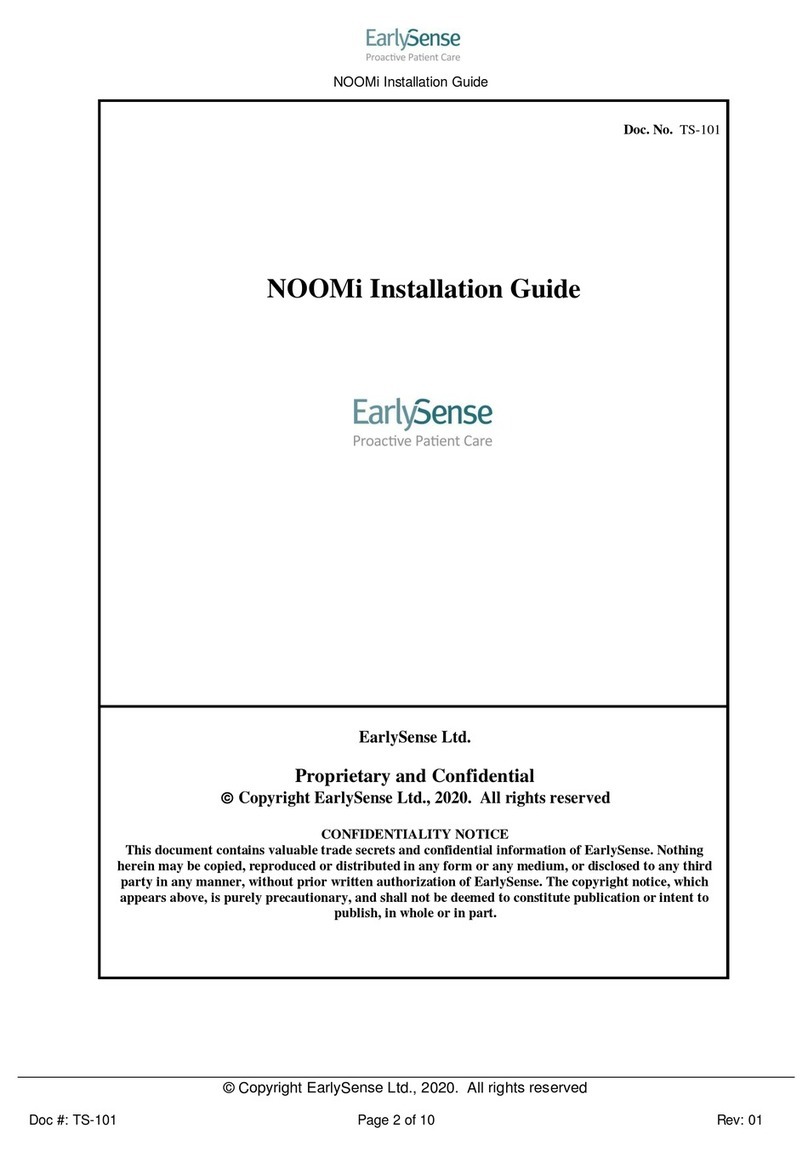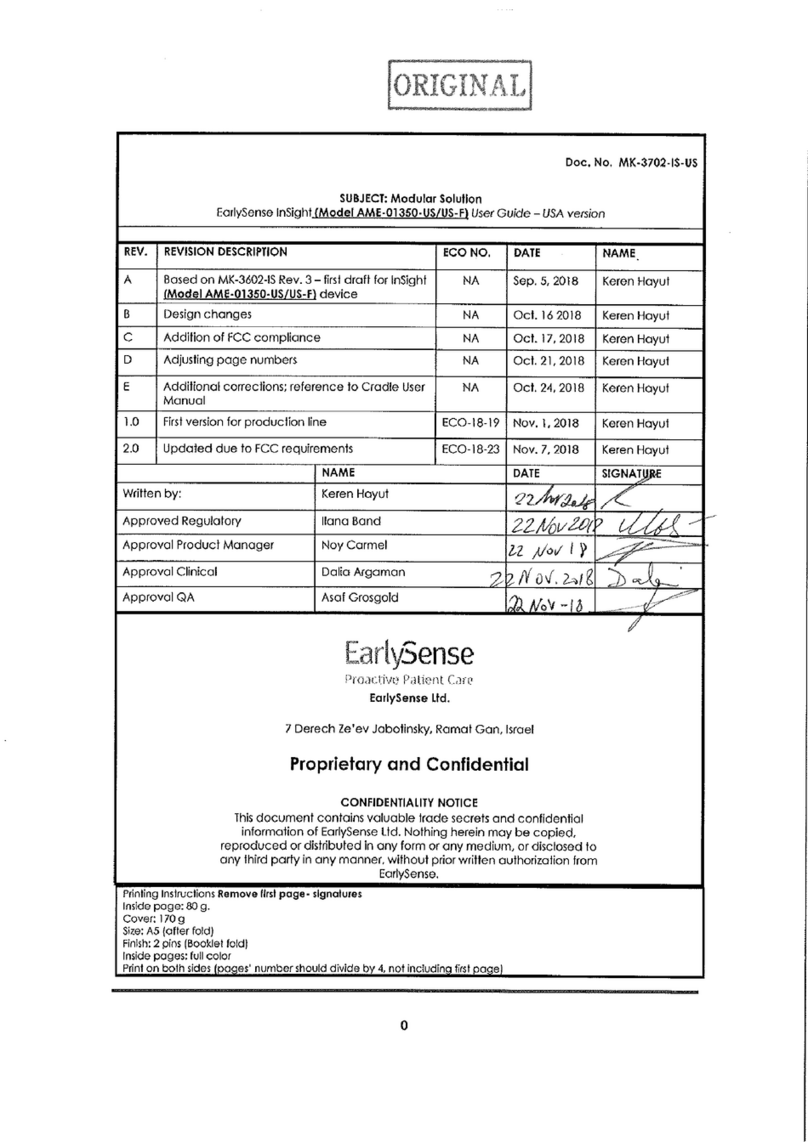
Cauon
US Federal Law restricts this device to sale by or
on the order of a Physician. The data acquired by
the EarlySense System should be interpreted by
a Health Care Professional only.
Intended Use
If using with EarlySense 2.0:
The EarlySense 2.0 System is intended for continuous measurement of
respiration rate, heart rate and movement, in an automatic contact-
less manner, at home, hospital or clinic setting. The system is indicated
for use in children, adolescents and adults. The operation of the
EarlySense has been studied in children (weight ≥ 10 Kg) and adults
(weight < 111 Kg) during sleep and resting condition. In addition,
the EarlySense 2.0 System can continuously monitor oxygen saturation
of arterial hemoglobin (SpO
2
) using pulse oximetry in pediatric
(ages 2 years and older), adolescents, and adults at home, hospital, or
clinical setting.
If using with EarlySense InSight:
The EarlySense InSight System is intended for continuous measurement
of respiratory rate, heart rate and movement in an automatic contact-
less manner, in hospital or clinical setting.The system is indicated for use
in children, adolescents and adults. The operation of the EarlySense has
been studied in children (weight ≥ 10 Kg) and adults (weight < 111 Kg)
during sleep and resting condition.
Explanaon of System Labels
Caution Manufactured by
Warning Date of
manufacture
Consult
accompanying
documents
MR Unsafe- Keep
away from
magnetic resonance
imaging (MRI)
equipment
Defibrillation
proof, type BF,
IP24 applied part
Temperature
limitation
Fragile, handle
with care Humidity limitation
Keep dry Atmospheric
pressure limitation
Indoor operation
only Rx Only
US Federal Law
restricts this device
to sale by or on the
order of a physician
Non-ionizing
Electromagnetic
Radiation This side up
Sorted disposal IP24
Solid object
protected and
splash-proof
accessory
Terms
HR Heart Rate
RR Respiratory Rate
General Safety Guidelines
General Hazards
• Do not use a damaged sensor. Use of damaged components might
result in malfunctioning of the system.
• This Insert includes only instruction for use for the contact-free sensing
element. For more detailed information and additional warning and
caution statement please refer to the system’s complete user manual.
• Handle the Sensing Unit with care. Do not drop, knock or shake the
Sensing Unit. Rough handling can damage the internal circuit boards.
• The Sensor is intended for indoor operation only.
• A damaged sensor should not be disposed of as unsorted municipal
waste. Contact your local distributor for unit disposal.
• Changes or modifications not expressly approved by EarlySense Ltd.
could affect the safety or effectiveness of the EarlySense Sensor
performance and void the warranty.
• The EarlySense Sensing Units can be used with the EarlySense
products.
• The contact-free sensor is continuously operated equipment and is
water-proof splash (IP24).
Compliance with standards
System complies with IEC60601-1-1 and IEC60601-1-2
Electromagnec Compability
This equipment complies with IEC 60601-1-2: for electromagnetic
compatibility for medical electrical equipment and/or systems.
This standard is designed to provide reasonable protection against
harmful interference in a typical medical installation. However, because
of the proliferation of radio frequency transmitting equipment and other
sources of electrical noise in healthcare and other environments, it is
possible that high levels of such interference due to close proximity
or strength of a source might disrupt the performance of this device.
Medical electrical equipment needs special precautions regarding EMC,
and all equipment must be installed by qualified service personnel.
Contraindicaons for Use
The EarlySense Sensor is contraindicated for use in:
• Patients in whom proper positioning cannot be achieved or
maintained.
• Patients who do not meet the weight limits tested or specified.
• An MR environment.
• An explosive atmosphere or in the presence of flammable anesthetics
or gases.
Warnings and Cauons
• EarlySense System should be installed and serviced only by qualified
service personnel authorized by the EarlySense Company.
• In the event that sensor does not operate properly, contact Customer
Support.
• Measurements may be affected by cable lengths. Do not shorten or
extend the lengths without authorized accessories.
• Care should be taken for patients with poor bladder functioning or
control, including small children, when an EarlySense Sensor is placed
under their mattress.
• Do not share the bed with another person or pet during
EarlySense System recording session. Sharing the bed could affect
the effectiveness of the system and the accuracy of the measurements.
• Avoid using heating blankets. Use of heating blankets could affect the
safety or effectiveness of the EarlySense System and void the system’s
warranty.
• Do not use the sensor for patients who weigh more than 200 kg
(440 Pounds). Usage of the System for such patients might result in
malfunction of the Sensing Unit.
• The patient should not have direct contact with the Sensing Unit.
A mattress, mattress pad or mattress cover should always be placed
as a barrier between the Sensing Unit of the EarlySense System and
the patient. Patients should be frequently checked to ensure direct
contact does not occur.
• Careful oversight should be provided when EarlySense System is used
with children.
•The monitoring with contact-free sensor is not intended for
monitoring high risk situations where ECG monitoring is required.
The most reliable method of patient monitoring combines close
personal surveillance with correct operation of the monitoring
equipment.
•The EarlySense technology and parameters have not been studied on
any specific patient group, neither has it been studied as a diagnostic
tool of any specific disease or medical condition. It is meant as an
adjunctive tool only for measuring respiratory rate, heart rate and
movement rate.
•As with all medical equipment, carefully route sensor cables and
connections to reduce the possibility of entanglement or strangulation.
Averssements et mises en garde
•Le système EarlySense doit être installé et entretenu par un personnel
de service qualifié uniquement, habilité par EarlySense Ltd.
•Si le capteur ne fonctionne pas correctement, contactez le service
client.
•Les mesures peuvent être affectées par les longueurs de câble.
Ne raccourcissez ni n’allongez les longueurs sans accessoires
autorisés.
•Il convient de faire attention avec les patients ne contrôlant pas bien
ou pas du tout leur vessie, notamment les jeunes enfants, lorsque
le capteur EarlySense est placé sous le matelas.
• Ne partagez pas le lit avec une autre personne ou un animal pendant
une session d’enregistrement avec le système EarlySense. Le partage
du lit peut nuire à l’efficacité du système et à la précision des mesures.
•Évitez d’utiliser des couvertures chauffantes. L’utilisation de
couvertures chauffantes peut nuire à la sécurité ou à l’efficacité du
système EarlySense et annuler la garantie du système.
•N’utilisez pas le capteur chez les patients pesant plus de 200 kg
(440livres). L’utilisation du système chez ces patients peut provoquer
un dysfonctionnement de l’unité de détection.
•Le patient ne doit pas être en contact direct avec l’unité de détection.
Un matelas, un surmatelas ou une housse de matelas doit toujours
être placé entre le capteur du système EarlySense et le patient.
Vérifiez régulièrement l’absence de contact direct entre le patient et
le capteur.
•Une surveillance rigoureuse est nécessaire lorsque le système
EarlySense est utilisé chez les enfants.
•Le monitorage avec capteur sans contact n’est pas destiné à
la surveillance de situations à haut risque lorsqu’un monitorage ECG
est requis. La méthode de monitorage de patient la plus fiable allie
une surveillance individuelle rigoureuse et un bon fonctionnement de
l’équipement de monitorage.
•La technologie et les paramètres EarlySense n’ont pas été étudiés sur
un groupe de patients spécifique. Ils n’ont pas non plus été étudiés en
tant qu’outil de diagnostic pour une maladie ou un état pathologique
spécifique. Il vise à être utilisé comme un outil supplémentaire
de mesure de la fréquence respiratoire, cardiaque et du taux de
mouvement.
•Comme pour tout équipement médical, acheminez avec précaution
les câbles et les branchements afin de réduire le risque d’emmêlement
ou d’étranglement.
Posioning the Sensing Units
Place the Bed Sensing Unit under the patient’s mattress (at least 7 cm /
3 inch thick) and locate it underneath the chest area of the patient
horizontally.
Position the sensor so the top surface is facing upwards (as marked)
Position the cord that connects the Sensor and the Bedside Unit so that
it comes out from under the mattress at the head of the bed, in order
to prevent interference with the movement of the patient getting in and
out of bed.
If the sensor is placed on a metal framework that does not allow solid
support for the sensor, please consult your authorized representative.
Please make sure the sensor cable is not trailing on the floor.
How to use
1. Place the sensing unit under the mattress.
2. Connect the EarlySense Sensing Unit to the designated connector on
your compatible device.
3. Refer to the complete relevant system’s instruction for user, for proper
system operation.
Sensor Components
• EarlySense Sensor
•A detachable cable connecting the Sensing Unit (Sensor) to
the Bedside Unit
Specicaons
Physical Characteristics
Dimensions 420 ×210 ×14 mm
Weight 800 gr
Operating Conditions
Relative Humidity 30% - 95% non-condensing
Ambient Operating Temperature 5-40 °C (41-104 °F)
Atmospheric pressure 700-1060 hPa
Storage and Transportation Conditions
Temperature Range -20-50 °C (-4-122 °F)
Relative Humidity 10%-90% non-condensing
Atmospheric pressure 500-1060 hPa
Cleaning and Disinfecon of the Sensing Unit
Please follow your institution guidance for bed mattress cleaning, in
order to clean the contact-less Bed Sensing Unit, that is placed under
the bed mattress. Cleaning detergents such as soft, wipes containing
alcohol, Chlorhexidine, Peroxide and bleach material or slightly damp
cloth/wipes containing anti-septic substances can be used. Please
ensure that the sensor is dry before re-use. Avoid excessive liquids.
Troubleshoong
For detailed troubleshooting please refer to system’s complete user
manual.
Maintenance
Maintaining the required highest level of sensitivity necessitates a
replacement of the sensor after 12 month of use. A clear notification is
provided to the user, when sensor replacement is required.
Contact EarlySense
Israel USA Ofce
EarlySense Ltd. (Manufacturer)
7 Derech Ze’ev Jabotinsky
Ramat Gan 5252007, Israel
Phone: +972-3-752-2330
Fax: +972-3-752-2340
800West Cummings Park, Suite 6400
Woburn, Massachusetts 01801, USA
Phone: +1-781-373-3228
Fax: +1-781-373-2367
www.earlysense.com
Mattress
Sensor under
chest area





















